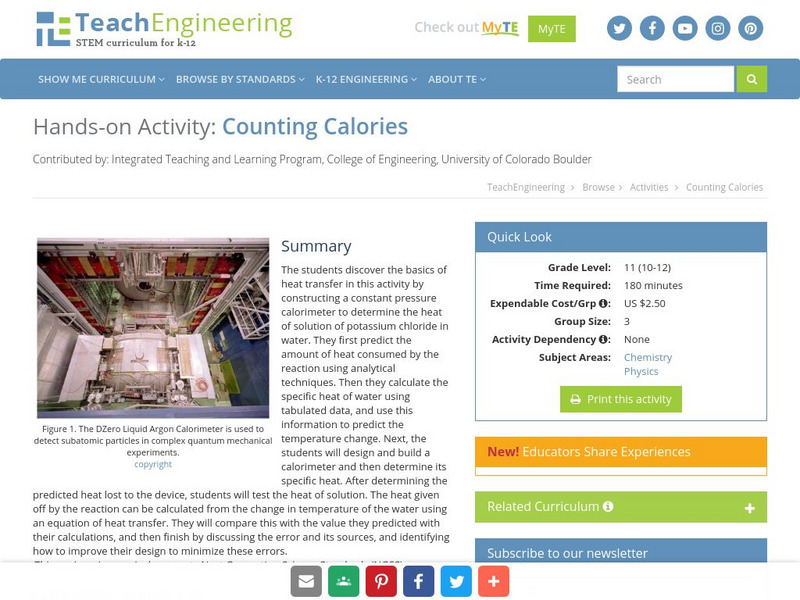Hi, what do you want to do?
ESL Flow
Natural Disasters
Learners examine different natural disasters. In this natural disaster lesson plan students complete a instructional activity that has the learners label the pictures of natural disasters and answer questions.
Curated OER
Airplane Propeller
Students examine the different kinds of propellers and their functions. In this airplane lesson students build a hand made propeller.
Curated OER
Volcano Demonstration
Learners watch a demonstration on how volcanoes work. In this volcano demonstration, students watch the teacher demonstrate a volcanic eruption. The teacher will change variables used to create the eruption and the learners will predict...
Curated OER
Three Main Rock Groups
Students are introduced to igneous, sedimentary and metamorphic rocks. They use foods to demonstrate the basic formation of each type of rock, read books about rock formation and view related videos.
Curated OER
Wind
Students complete activities to study wind intensity. In this wind study lesson plan, students discuss wind speed and direction. Students then build a kite and windsock to help them study wind intensity. Students learn to use a wind...
Curated OER
What Floats Your Boat?
Students discover the Archimedes principle through a buoyancy experiment. They measure the water displacement of a lump a clay which is denser than water then reshape the clay into a bowl which floats but displaces more water.
Curated OER
Bottle Rocket Lesson
Students design a rocket that stays on air for the longest period of time. In this physics lesson, students research the function of different rocket components. They test their design and make necessary modifications.
Curated OER
Will It Rain Today or Tomorrow?
Pupils examine how to forecast weather. They examine the different types of weather and learn the correct vocabulary.
Curated OER
Glacier Climbing
Young scholars discuss glaciers and the current distribution of glaciers around the Earth. They create simulated glaciers using cornstarch, shoeboxes, water, and pebbles.
Curated OER
Solid Waste/Recycling
Students see that when we throw away garbage, it usually ends up in a landfill. Landfill space is getting increasingly scarce, and every time we throw something away we throw with it the energy, the money, and the raw materials it took...
Curated OER
CALORIE COUNTDOWN
Students will categorize foods according to their components and energy content.1. Design a large bulletin board with sections for carbohydrates, fats and proteins.
2. Ask students to bring labels and packages of different food products....
Curated OER
Scientist/ Webelos Activity Book
In this physical science worksheet, students write short responses for each scientific law in 14 different questions to obtain a merit badge.
Curated OER
Problem Based Learning Scenario
Students research about the function of MPA's. In this marine science lesson, students explore how humans influence changes near these areas. They explore different MPA's in the Great Lakes region.
Curated OER
Reading Comprehension 4: Level 8
Need a quick but comprehensive reading strategies exercise? Even your most reluctant readers will be engaged by the story of a nuclear reactor explosion at a top-secret Idaho base. After reading the short passage, learners answer nine...
Curated OER
Promoting Inquiry Throught Computer-Based Labs
Student Teachers are given the opportunity to examine how to use a computer-based laboratory for inquiry. The practice is done to teach future teachers how to use these tools so they can be ready for use in the classroom environment.
Curated OER
Plate Tectonic - Volcanoes Post Lab
First graders draw an erupting volcano. They learn the components of an erupting volcano.
Curated OER
What Makes Popcorn Pop?
Students experiment with making popcorn to discover what makes it pop. They cook various types to survey which brand gives the highest volume of corn.
Curated OER
Let's Go! Virtual Yellowstone Tour
Students research the geologic wonders of Yellowstone National Park. They locate the main geologic features of Yellowstone on a map of the park. Students write a description of the geologic features to be included on the map for a...
TeachEngineering
Teach Engineering: Too Much Pressure!
In this activity, students learn how engineers design faucets. Students will learn about water pressure by building a simple system to model faucets and test the relationship between pressure, area and force. This is a great outdoor...
TeachEngineering
Teach Engineering: What Floats Your Boat?
Students use modeling clay, a material that is denser than water and thus ordinarily sinks in water, to discover the principle of buoyancy. They begin by designing and building boats out of clay that will float in water, and then refine...
PBS
Pbs Teachers: Build a Model Dam
Discover the unique engineering properties of a dam by contructing a model dam using popsicle sticks, pebbles and sand.
TeachEngineering
Teach Engineering: Counting Calories
The students discover the basics of heat transfer in this activity by constructing a constant pressure calorimeter to determine the heat of solution of potassium chloride in water. They first predict the amount of heat consumed by the...
TeachEngineering
Teach Engineering: Pop Rockets
Students design and build a paper rocket around a film canister, which is used as the engine. An antacid tablet and water are put into the canister, react to form carbon dioxide gas, and act as the pop rocket's propellant. With the lid...
TeachEngineering
Teach Engineering: Air Pollution
Students are introduced to the concept of air quality by investigating the composition, properties, atmospheric layers and everyday importance of air. They explore the sources and effects of visible and invisible air pollution. By...




























